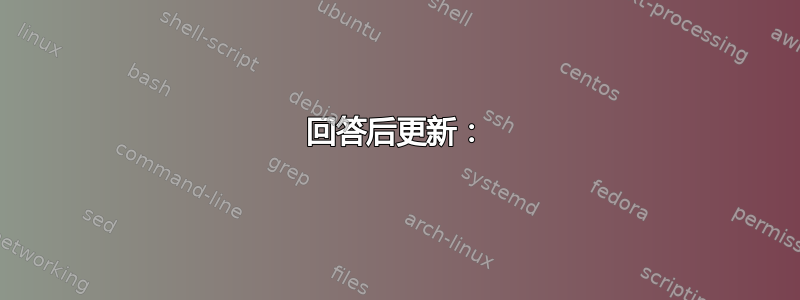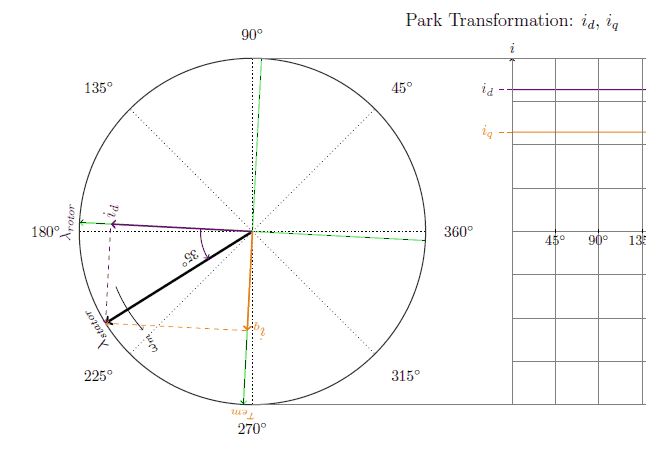
回答后更新:
- 在使用下面非常有用的答案后,我的动画现在看起来像这样,并且所有标签都“粘”在了适当的位置。非常感谢!*

原始问题:
我有以下旋转动画:

如您所见,标签的行为很奇怪,尤其是红色标签和 35 度角标签。是否可以将标签附加到相对于箭头的固定点,该点在旋转箭头时不会发生变化?
我的全部代码都在这里,有问题的标签位于第 239、257 和 280 行。
\documentclass[tikz,border=10pt]{standalone}
\usepackage{ifthen}
\usepackage{pgfplots}
\usepackage{amsmath} % Required for \varPsi below
\usepackage{tikz}
\usepackage{animate}
\usetikzlibrary{calc}
\pgfplotsset{compat=1.9}
\newcommand{\gettikzxy}[3]{%
\tikz@scan@one@point\pgfutil@firstofone#1\relax
\edef#2{\the\pgf@x}%
\edef#3{\the\pgf@y}%
}
\begin{document}
\foreach \angle in {1,2,...,3}{ %Create all the frames with different angle (DEFAULT IS {360,359,...,1} - but that takes about 20min rendering time)
\begin{tikzpicture}
%Definitions - These can be changed to create new figures%
%===========================================================
\pgfmathsetmacro \Vmax {8/3}; %Max phase voltage (in cm) (8/3 or 2.667 cm is default as that will create a 4 cm space vector)
%\def \Vs {4}; %Magnitude of space vector in cm OLD
\def \Angle {\angle}; %Angle with regards to phase A
\def \Osv {35}; %Angle of d-axis wrt space vector
\def \R {2.5}; %Magnitude of rotor flux in cm
%Calculated variables. These should not be changed unless you know what you are doing%
%===========================================================
\pgfmathsetmacro \Vs {\Vmax * 1.5}; %Magnitude of space vector in cm
\pgfmathsetmacro \MaxLin {\Vs * cos{30}}; %Magnitude before overmodulation
\pgfmathsetmacro \Qmag {\Vs * sin{\Osv})}; %Magnitude of Q axis
\pgfmathsetmacro \Dmag {\Vs * cos{\Osv})}; %Magnitude of Q axis
\pgfmathsetmacro \Marker {\Angle/45)};
%\pgfmathsetmacro \Vmax {\Vs * 2/3}; %Max phase voltage (OLD)
\def \Axisheight {\Vmax *3};
\pgfmathsetmacro \Va {\Vmax * sin{(\Angle+0)}}; %Magnitude of phase A at angle \Angle
\pgfmathsetmacro \Vb {\Vmax * sin{(\Angle+120)}}; %Magnitude of phase B at angle \Angle
\pgfmathsetmacro \Vc {\Vmax * sin{(\Angle+240)}}; %Magnitude of phase C at angle \Angle
\pgfmathsetmacro \Radius {\Vmax}; %Radius of maximum line to line voltage output
%Locations%
%===========================================================
\def \OrigoX {-6 cm}; % If you want to move the circle relative to the wave forms (default -6cm)
\def \OrigoY {0 cm};
\def \OrigoYb {-11 cm};
\def \OrigoYc {-22 cm};
\coordinate (origo) at (\OrigoX,\OrigoY); %Center of top phasor diagram
\coordinate (origob) at (\OrigoX,\OrigoYb); %Center of center phasor diagram
\coordinate (origoc) at (\OrigoX,\OrigoYc); %Center of bottom phasor diagram
\coordinate (phase_a) at (0:\Va cm); %Tip of phase A
\coordinate (phase_b) at (120:\Vb cm); %Tip of phase B
\coordinate (phase_c) at (240:\Vc cm) ; %Tip of phase C
\coordinate (Y) at (\OrigoX+\Vs cm ,\OrigoY+0); %Where to start the Hexagon
%Circle background rings%
%===========================================================
\node at (origo) [circle,thick,draw=black!80,fill=red!0, inner sep=0pt,minimum size=\Vs*2 cm] {}; %Top Circle with radius 128%
\node at (origob) [circle,thick,draw=black!80,fill=red!0, inner sep=0pt,minimum size=\Vs*2 cm] {}; %Center Circle with radius 128%
\node at (origoc) [circle,thick,draw=black!80,fill=red!0, inner sep=0pt,minimum size=\Vs*2 cm] {}; %Center Circle with radius 128%
%Left axis to top circle
\draw[<->] (1.95*\OrigoX,-1.1*\Vs cm) -- (1.95*\OrigoX,1.1*\Vs cm) node[anchor=south, distance=0.2cm]{$I$};
\draw [color=black,dotted](\OrigoX,\Vs cm)--(2*\OrigoX,\Vs cm) node[anchor=east, distance=0.5cm] {$\frac{3}{2}i - 150\%$};
%\draw [color=red,dotted] (\OrigoX,\MaxLin cm) -- (2*\OrigoX,\MaxLin cm) node[anchor=east, distance=0.5cm] {$\frac{2\sqrt{3}}{3}I_{max} - 115,5\%$};
\draw [color=black,dotted](\OrigoX,\Vmax cm) -- (2*\OrigoX,\Vmax cm) node[anchor=east] {$i - 100\%$};
\draw [color=black,dotted](\OrigoX,0 cm) -- (2*\OrigoX,0 cm) node[anchor=east] {$0\%$};
%Hexagon Framing around phasors%
%===========================================================
%\draw[-, color=black!50,thin,dashed] (Y) -- ++(120:\Vs cm) -- ++(180:\Vs cm) -- ++(240:\Vs cm) -- ++(300:\Vs cm) -- ++(360:\Vs cm) -- ++(60:\Vs cm); % Six step hexagon
%\node at (origo) [circle,draw=red!80, inner sep=0pt,minimum size=\MaxLin*2 cm] {}; %Circle with radius 115%
%Black guide lines with angle notation
\foreach \x in {45,90,...,360} {
\draw[-,color=black,dotted, thin] (origo) -- ++(\x:\Vs cm) node[label={[label distance=-0.18cm]\x: $\x^{\circ}$}] {};
} \foreach \x in {45,90,...,360} {
\draw[-,color=black,dotted, thin] (origob) -- ++(\x:\Vs cm) node[label={[label distance=-0.18cm]\x: $\x^{\circ}$}] {};
} \foreach \x in {45,90,...,360} {
\draw[-,color=black,dotted, thin] (origoc) -- ++(\x:\Vs cm) node[label={[label distance=-0.18cm]\x: $\x^{\circ}$}] {};
}
%=============================================================================================================
%Actual three phase phasors%
%=============================================================================================================
\node [above, align=center] at (0,4.5) [anchor=south] {\large Three-phased current meassurement: $i_a$, $i_b$, $i_c$}; %Label overhead figure 1
\node at (origo) [circle,thick,draw=black!80, inner sep=0pt,minimum size=\Vmax*2 cm] {}; %Circle with radius 100%
\draw[->,color=red, very thick] (origo) -- ++(phase_a); %Phase A phasor
\draw[->,color=blue, very thick] (origo) -- ++(phase_b); %Phase B phasor
\draw[->,color=green, very thick] (origo) -- ++(phase_c); %Phase C phasor
\draw[color=red,thick,smooth,domain=0:8] plot(\x,{\Vmax * sin(\x*45)}); % Phase A
\draw[color=blue,thick,,smooth,domain=0:8] plot(\x,{\Vmax * sin((\x*45)+120)}); %Phase B
\draw[color=green,thick,,smooth,domain=0:8] plot(\x,{\Vmax * sin((\x*45)+240)}); % Phase C
\draw[color=red,dashed] (\Marker,\Va) -- (-0.3,\Va) node[anchor=east] {$i_a$};; %A phase line to Y-axis
\draw[color=blue,dashed] (\Marker,\Vb)-- (-0.3,\Vb) node[anchor=east] {$i_b$};; %B phase line to Y-axis
\draw[color=green,dashed] (\Marker,\Vc)-- (-0.3,\Vc) node[anchor=east] {$i_c$};; %C phase line to Y-axis
%SPACE VECTOR %
\draw[->,ultra thick,black] (origo) -- ++($(phase_a) + (phase_b) + (phase_c)$) coordinate(Vstip); %Space vector resultant
\pgfgetlastxy{\XCoord}{\YCoord}; % X and Y coordinates of Space vector tip
%Find space vector angle
\pgfmathanglebetweenpoints{\pgfpointanchor{origo}{center}}{\pgfpointanchor{Vstip}{center}}
\let\PhaseBlack\pgfmathresult;
%Phasor guide lines%
\draw[-,color=red, dashed] (origo) -- ++(0:\Vmax cm) node[anchor=west] {\large $i_a$};
\draw[-,color=blue, dashed] (origo) -- ++(120:\Vmax cm) node[anchor=south] {\large $i_b$};
\draw[-,color=green, dashed] (origo) -- ++(240:\Vmax cm) node[anchor=north] {\large $i_c$};
\draw[-,color=red, dashed] (origo) -- ++(0:-\Vmax cm) node[anchor=east] {$-i_a$};
\draw[-,color=blue, dashed] (origo) -- ++(120:-\Vmax cm) node[anchor=north] {$-i_b$};
\draw[-,color=green, dashed] (origo) -- ++(240:-\Vmax cm) node[anchor=south] {$-i_c$};
\draw[->,color=blue, thin] (origo) ++(phase_a) -> ++(phase_b); %Resultant help lines
\draw[->,color=green, thin] (origo) ++(phase_a) ++(phase_b) -> ++(phase_c); %Resultant help lines
\draw[color=gray] (\OrigoX,\Vmax) -- (9,\Vmax) ; %X axis TOP inner
\draw[color=gray] (\OrigoX,-\Vmax) -- (9,-\Vmax) ; %X axis bottom inner
%% Rotor Flux Vector%
%\coordinate (rfluxtip) at (\PhaseBlack-\Osv:\R); %Tip of rotor flux
%\draw[->,color=gray] (origo) -- ++(rfluxtip) node[label={[label distance=-0.18cm]\PhaseBlack-\Osv: $\lambda_r$}] {}; %Rotor Flux Phasor
%Wave form
\draw[->, color=black] (0,0) -- (9,0) node[anchor=west] {$\theta$}; %X axis
\draw[->, color=black] (0,-\Vs) -- (0,\Vs) node[anchor=south] {$i$}; %Y axis
%\draw[help lines] (0,-\Vs) grid (9 ,\Vs); %Grid
%X Axis help lines
\foreach \x in {1, 2,...,8} {
\draw[color=lightgray] (\x cm,\Vs cm) -- (\x cm,-\Vs cm) {};
}
%X Axis tick marks
\foreach \x in {1, 2,...,8} {
\pgfmathsetmacro \tick {\x * 45};
\draw (\x cm,1pt) -- (\x cm,-1pt) node[anchor=north] {\small\pgfmathprintnumber[fixed, precision=10]{\tick}$^{\circ}$};
}
%Marker to illustrate angle position over wave forms
\draw[color=black] (\Marker cm, \Vs cm) -- (\Marker cm, -\Vs cm) node[anchor=north,align=center]{$\Angle^{\circ}$};
%Top and bottom border, extending to circle top and and bottom
\draw[color=gray] (\OrigoX,\Vs) -- (9,\Vs) ; %X axis TOP outer
\draw[color=gray] (\OrigoX,-\Vs) -- (9,-\Vs) ; %X axis bottom outer
%=============================================================================================================
%Alpha and Beta Phasors
%=============================================================================================================
\node [above, align=center] at (0,-6.5) [anchor=south] {\large Clarke Transformation: $i_\alpha$, $i_\beta$}; %Label overhead figure 2
%SPACE VECTOR %
\draw[->,ultra thick,black] (origob) -- ++($(phase_a) + (phase_b) + (phase_c)$) coordinate(Vstipb); %Space vector resultant
\pgfgetlastxy{\XCoordb}{\YCoordb}; % X and Y coordinates of Space vector tip
%Find space vector angle
\pgfmathanglebetweenpoints{\pgfpointanchor{origob}{center}}{\pgfpointanchor{Vstipb}{center}}
\let\PhaseBlackb\pgfmathresult;
%Green Axis system rotated to rotor angle
\draw[-,color=green] (\OrigoX,\OrigoYb-\Vs cm) -- ++(90:2*\Vs cm);
\draw[-,color=green] (\OrigoX+\Vs cm,\OrigoYb) -- ++(0:-2*\Vs cm);
\draw[->,color=violet, thin, dashed] (\OrigoX, \YCoordb) -> (Vstipb); %Beta help Line
\draw[->,color=orange, thin, dashed] (\XCoordb, \OrigoYb) -> (Vstipb); %Alpha help Line
\draw[->,color=violet, very thick] (origob) -- ++(0,\YCoordb-\OrigoYb) node[anchor=north east] {\large $i_\beta$}; %Phase beta phasor
\draw[->,color=orange, very thick] (origob) -- ++(\XCoordb-\OrigoX,0) node[anchor=north] {\large $i_\alpha$}; %Phase alpha phasor
\coordinate (origobb) at (0,\OrigoYb); %Center of center phasor diagram
\draw[color=violet,thick,smooth,domain=0:8, shift=(origobb)] plot(\x,{\Vs * sin((\x*45)+90)}); % Beta wave form
\draw[color=orange,thick,smooth,domain=0:8, shift=(origobb)] plot(\x,{\Vs * sin((\x*45)+0)}); % Alpha wave form
\draw[color=violet,dashed] (\Marker,\YCoordb)-- (-0.3,\YCoordb) node[anchor=east] {$i_\beta$};; %Beta line to beta-axis
\draw[color=orange,dashed] (\Marker,\XCoordb-\OrigoX+\OrigoYb)-- (-0.3,\XCoordb-\OrigoX+\OrigoYb) node[anchor=east] {$i_\alpha$};; %Alpha line to alpha-axis
%Wave form
\draw[->, color=black] (0,\OrigoYb) -- (9,\OrigoYb) node[anchor=west] {$\theta$}; %X axis middle
\draw[->, color=black] (0,\OrigoYb-\Vs cm) -- (0,\OrigoYb+\Vs cm) node[anchor=south] {$i$}; %Y axis middle
\draw[help lines] (0,\OrigoYb-\Vs cm) grid (9 ,\OrigoYb+\Vs cm); %Grid middle
%X Axis tick marks
\foreach \x in {1, 2,...,8} {
\pgfmathsetmacro \tick {\x * 45};
\draw (\x cm,\OrigoYb-1pt) -- (\x cm,\OrigoYb+1pt) node[anchor=north] {\small\pgfmathprintnumber[fixed, precision=10]{\tick}$^{\circ}$};
}
%Marker to illustrate angle position over wave forms
\draw[color=black] (\Marker cm,\OrigoYb+\Vs cm) -- (\Marker cm, \OrigoYb-\Vs cm) node[anchor=north,align=center]{ $\Angle^{\circ}$};
%Top and bottom border, extending to circle top and and bottom
\draw[color=gray] (\OrigoX,\OrigoYb+\Vs cm) -- (9,\OrigoYb+\Vs cm) ; %X axis TOP outer
\draw[color=gray] (\OrigoX,\OrigoYb-\Vs cm) -- (9,\OrigoYb-\Vs cm) ; %X axis bottom outer
%=============================================================================================================
%%D and Q Phasors%
%=============================================================================================================
\node [above, align=center] at (0,-17.5) [anchor=south] {\large Park Transformation: $i_d$, $i_q$}; %Label overhead figure 3
%Space Vector
\draw[->,ultra thick,black] (origoc) -- ++($(phase_a) + (phase_b) + (phase_c)$) node[label={[label distance=0.1 cm,,rotate=\PhaseBlackb-90, color=red]\PhaseBlackb-90: $\lambda_{stator}$}] {} coordinate(Vstipc); %Space vector resultant
\pgfgetlastxy{\XCoordc}{\YCoordc}; % X and Y coordinates of Space vector tip
%Find space vector angle
\pgfmathanglebetweenpoints{\pgfpointanchor{origoc}{center}}{\pgfpointanchor{Vstipc}{center}}
\let\PhaseBlackc\pgfmathresult;
\coordinate (d1c) at (\PhaseBlackc-\Osv:\Vs cm) ; %Tip of d axis
\coordinate (d2c) at (\PhaseBlackc-\Osv:-\Vs cm) ; %Tip of d axis
\coordinate (q1c) at (\PhaseBlackc-\Osv+90:\Vs cm) ; %Tip of q axis
\coordinate (q2c) at (\PhaseBlackc-\Osv+90:-\Vs cm) ; %Tip of q axis
\coordinate (d3c) at (\PhaseBlackc-\Osv+90:\Qmag) ; %Tip of d
\coordinate (q3c) at (\PhaseBlackc-\Osv:\Dmag) ; %Tip of q
\draw[->,color=orange, thin, dashed] (origoc) -- ++(d3c) -> (Vstipc); %Q help Line
\draw[->,color=violet, thin, dashed] (origoc) -- ++(q3c) -> (Vstipc); %Q help Line
\draw[->,color=green, thick] (origoc) -- ++(d1c) node[label={[label distance=0.1 cm,rotate=\PhaseBlackc-\Osv-90, color=red]\PhaseBlackc-\Osv-90: $\lambda_{rotor}$}] {}; %D axis help line
\draw[-,color=green, thin] (origoc) -- ++(d2c); %D axis help line
\draw[-,color=green, thick] (origoc) -- ++(q1c); %Q axis help line
\draw[-,color=green, thin] (origoc) -- ++(q2c); %Q axis help line
\draw[->,color=orange, very thick] (origoc) -- ++(d3c) node[label={[label distance=-0.18cm]\PhaseBlackc-\Osv+90:\large $i_q$}] {}; %q phasor
\draw[->,color=violet, very thick] (origoc) -- ++(q3c) node[label={[label distance=-0.18cm]\PhaseBlackc-\Osv:\large $i_d$}] {}; %d phasor
\coordinate (origocc) at (0,\OrigoYc); %Center of center phasor diagram
\draw[color=orange,thick,,smooth,domain=0:8, shift=(origocc)] plot(\x,{\Qmag}); % Q
\draw[color=violet,thick,,smooth,domain=0:8, shift=(origocc)] plot(\x,{\Dmag}); % D
\draw[color=orange,dashed] (0,\OrigoYc+\Qmag cm)-- (-0.3,\OrigoYc+\Qmag cm) node[anchor=east] {$i_q$}; %d line to y axis
\draw[color=violet,dashed] (0,\OrigoYc+\Dmag cm)-- (-0.3,\OrigoYc+\Dmag cm) node[anchor=east] {$i_d$}; %q line to y axis
%% Rotor Flux Vector%
%\coordinate (rfluxtipc) at (\PhaseBlackc-\Osv:\R); %Tip of rotor flux
%\draw[->,color=yellow, thick] (origoc) -- ++(rfluxtipc) node[anchor=west] {$\lambda_r$}; %Bottom Rotor Flux Phasor
% angular velocity \omega
\draw[->] (\OrigoX,\OrigoYc) ++(\PhaseBlackc-10:.85*\Vs) arc (\PhaseBlackc-10:\PhaseBlackc+10:.85*\Vs) node[label={[label distance=0.1 cm,rotate=\PhaseBlackc-90]left: $\omega_{m}$}] {};
% Angle between rotor and stator
\draw[->, thick] (\OrigoX,\OrigoYc) ++(\PhaseBlackc-\Osv:.35*\Vs) arc (\PhaseBlackc-\Osv:\PhaseBlackc:.35*\Vs) node[label={[label distance=0.0 cm]below: \small $\Osv^{\circ}$}] {};
%WAVE FORM%
\draw[->, color=black] (0,\OrigoYc) -- (9,\OrigoYc) node[anchor=west] {$\theta$}; %X axis bottom
\draw[->, color=black] (0,\OrigoYc-\Vs cm) -- (0,\OrigoYc+\Vs cm) node[anchor=south] {$i$}; %Y axis bottom
\draw[help lines] (0,\OrigoYc-\Vs cm) grid (9 ,\OrigoYc+\Vs cm); %Grid middle
%X Axis tick marks
\foreach \x in {1, 2,...,8} {
\pgfmathsetmacro \tick {\x * 45};
\draw (\x cm,\OrigoYc-1pt) -- (\x cm,\OrigoYc+1pt) node[anchor=north] {\small\pgfmathprintnumber[fixed, precision=10]{\tick}$^{\circ}$};
}
%Marker to illustrate angle position over wave forms
\draw[color=black] (\Marker cm,\OrigoYc+\Vs cm) -- (\Marker cm, \OrigoYc-\Vs cm) node[anchor=north,align=center]{$\Angle^{\circ}$};
%Top and bottom border, extending to circle top and and bottom
\draw[color=gray] (\OrigoX,\OrigoYc+\Vs cm) -- (9,\OrigoYc+\Vs cm) ; %X axis TOP outer
\draw[color=gray] (\OrigoX,\OrigoYc-\Vs cm) -- (9,\OrigoYc-\Vs cm) ; %X axis bottom outer
\end{tikzpicture}}
\end{document}
如果要创建动画,您还应该在同一文件夹中的单独文件中编写此代码:(然后上述代码应命名为“frames2”)还要注意第一个文件第 17 行的注释。完整的 360 度渲染需要大量时间,因此我通常在测试时以 4 个不同的角度渲染以检查结果(例如 \foreach \angle in {1,90,180,270})。
\documentclass{standalone}
\usepackage{animate}
\begin{document}
\animategraphics[controls,autoplay,loop]{72}{frames2}{}{} %Create animation of the output file with all the frames
\end{document}
答案1
这里有两个生成“附加标签”的示例,一个使用transform shape,另一个使用旋转校正。
\documentclass[tikz,border=7mm]{standalone}
\usetikzlibrary{calc}
\begin{document}
\begin{tikzpicture}
\foreach \i in {0,30,..., 330}
\draw[red, ->, rotate=\i, transform shape] (0,0) -- +(0:3) node[rotate=-90,above]{fixed};
\foreach \i in {0,30,..., 330}
\draw[->] (7,0) -- +(\i:3) node[rotate=\i-90,above]{fixed};
\end{tikzpicture}
\end{document}



